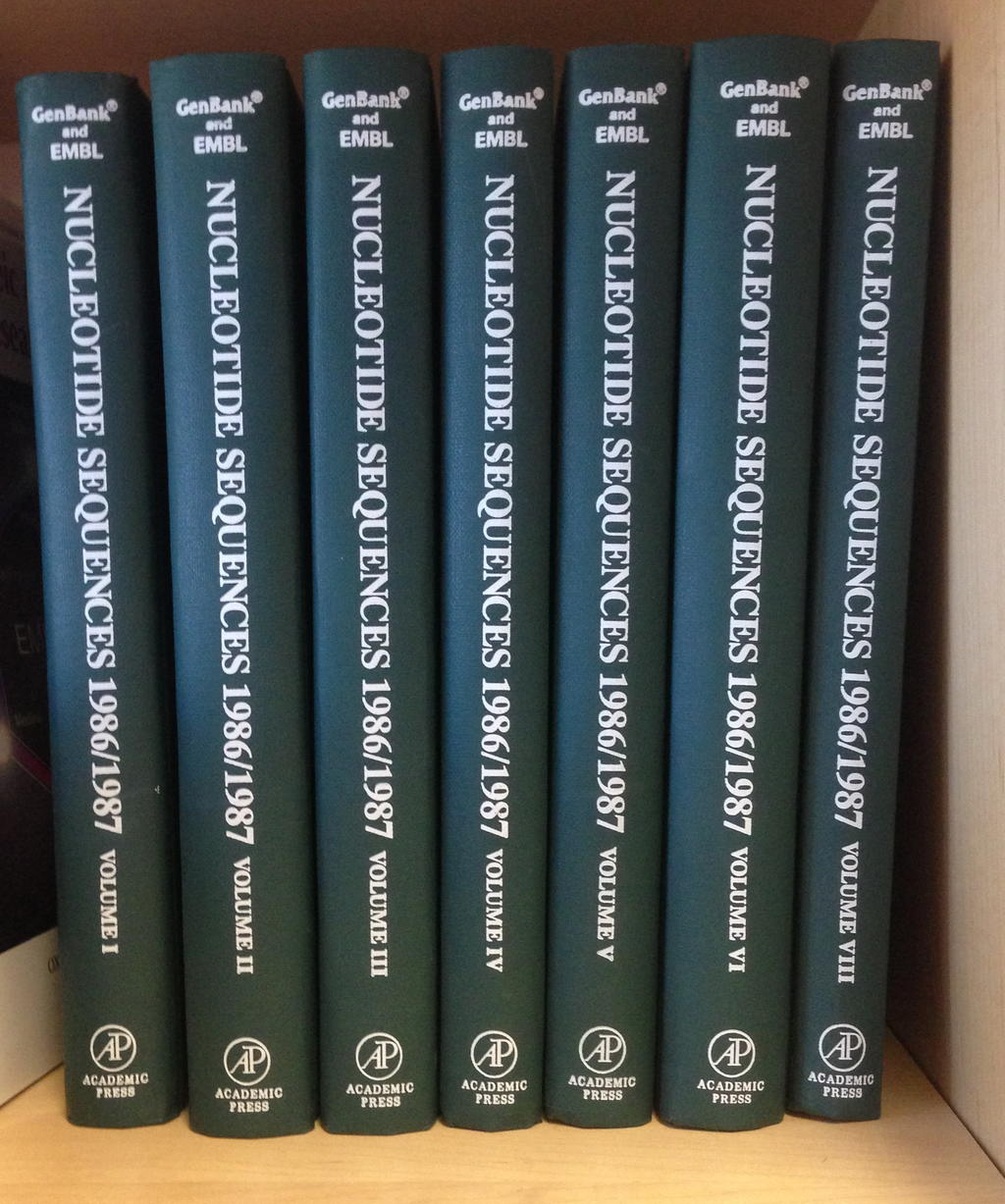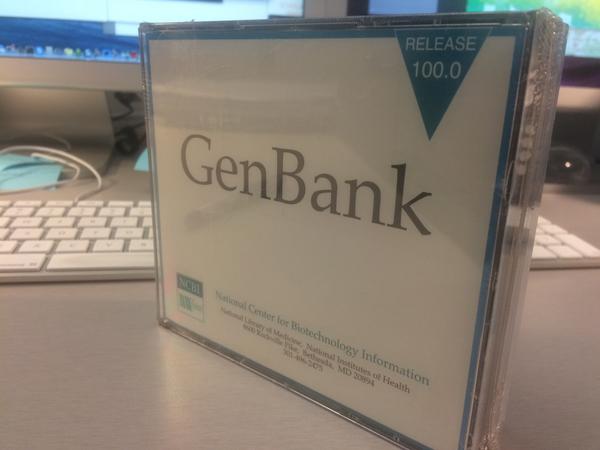GenBank on:
[Wikipedia]
[Google]
[Amazon]
The GenBank sequence database is an open access, annotated collection of all publicly available nucleotide sequences and their
/ref> As one of the earliest bioinformatics community projects on the Internet, the GenBank project started BIOSCI/Bionet news groups for promoting open access communications among bioscientists. During 1989 to 1992, the GenBank project transitioned to the newly created National Center for Biotechnology Information (NCBI).

GenBankExample sequence record, for hemoglobin betaBankIt
— a stand-alone software tool developed by the NCBI for submitting and updating entries to the GenBank sequence database.
EMBOSS
— free, open source software for molecular biology
GenBank, RefSeq, TPA and UniProt: What's in a Name?
{{Authority control National Institutes of Health Genetics databases Genome databases Bioinformatics Biological databases
protein
Proteins are large biomolecules and macromolecules that comprise one or more long chains of amino acid residue (biochemistry), residues. Proteins perform a vast array of functions within organisms, including Enzyme catalysis, catalysing metab ...
translations. It is produced and maintained by the National Center for Biotechnology Information
The National Center for Biotechnology Information (NCBI) is part of the National Library of Medicine (NLM), a branch of the National Institutes of Health (NIH). It is approved and funded by the government of the United States. The NCBI is lo ...
(NCBI; a part of the National Institutes of Health
The National Institutes of Health (NIH) is the primary agency of the United States government responsible for biomedical and public health research. It was founded in 1887 and is part of the United States Department of Health and Human Service ...
in the United States
The United States of America (USA), also known as the United States (U.S.) or America, is a country primarily located in North America. It is a federal republic of 50 U.S. state, states and a federal capital district, Washington, D.C. The 48 ...
) as part of the International Nucleotide Sequence Database Collaboration (INSDC).
In October 2024, GenBank contained 34 trillion base pairs from over 4.7 billion nucleotide sequences and more than 580,000 formally described species
A species () is often defined as the largest group of organisms in which any two individuals of the appropriate sexes or mating types can produce fertile offspring, typically by sexual reproduction. It is the basic unit of Taxonomy (biology), ...
.
The database started in 1982 by Walter Goad and Los Alamos National Laboratory. GenBank has become an important database for research in biological fields and has grown in recent years at an exponential rate by doubling roughly every 18 months.
GenBank is built by direct submissions from individual laboratories, as well as from bulk submissions from large-scale sequencing centers.
Submissions
Only original sequences can be submitted to GenBank. Direct submissions are made to GenBank using BankIt, which is a Web-based form, or the stand-alone submission program, table2asn. Upon receipt of a sequence submission, the GenBank staff examines the originality of the data and assigns an accession number to the sequence and performs quality assurance checks. The submissions are then released to the public database, where the entries are retrievable by Entrez or downloadable byFTP
The File Transfer Protocol (FTP) is a standard communication protocol used for the transfer of computer files from a server to a client on a computer network. FTP is built on a client–server model architecture using separate control and dat ...
. Bulk submissions of Expressed Sequence Tag (EST), Sequence-tagged site (STS), Genome Survey Sequence (GSS), and High-Throughput Genome Sequence (HTGS) data are most often submitted by large-scale sequencing centers. The GenBank direct submissions group also processes complete microbial genome sequences.
History
Walter Goad of the Theoretical Biology and Biophysics Group at Los Alamos National Laboratory (LANL) and others established the Los Alamos Sequence Database in 1979, which culminated in 1982 with the creation of the public GenBank. Funding was provided by theNational Institutes of Health
The National Institutes of Health (NIH) is the primary agency of the United States government responsible for biomedical and public health research. It was founded in 1887 and is part of the United States Department of Health and Human Service ...
, the National Science Foundation, the Department of Energy, and the Department of Defense. LANL collaborated on GenBank with the firm Bolt, Beranek, and Newman, and by the end of 1983 more than 2,000 sequences were stored in it.
In the mid-1980s, the Intelligenetics bioinformatics company at Stanford University
Leland Stanford Junior University, commonly referred to as Stanford University, is a Private university, private research university in Stanford, California, United States. It was founded in 1885 by railroad magnate Leland Stanford (the eighth ...
managed the GenBank project in collaboration with LANL.LANL GenBank History/ref> As one of the earliest bioinformatics community projects on the Internet, the GenBank project started BIOSCI/Bionet news groups for promoting open access communications among bioscientists. During 1989 to 1992, the GenBank project transitioned to the newly created National Center for Biotechnology Information (NCBI).


Growth
The GenBank release notes for release 250.0 (June 2022) state that "from 1982 to the present, the number of bases in GenBank has doubled approximately every 18 months". As of 15 June 2022, GenBank release 250.0 has over 239 million loci, 1,39 trillion nucleotide bases, from 239 million reported sequences. The GenBank database includes additional data sets that are constructed mechanically from the main sequence data collection, and therefore are excluded from this count.Limitations
An analysis of Genbank and other services for the molecular identification of clinical blood culture isolates using 16S rRNA sequences showed that such analyses were more discriminative when GenBank was combined with other services such as EzTaxon-e and the BIBI databases. GenBank may contain sequences wrongly assigned to a particular species, because the initial identification of the organism was wrong. A recent study showed that 75% of mitochondrial Cytochrome c oxidase subunit I sequences were wrongly assigned to the fish '' Nemipterus mesoprion'' resulting from continued usage of sequences of initially misidentified individuals. The authors provide recommendations how to avoid further distribution of publicly available sequences with incorrect scientific names. Numerous published manuscripts have identified erroneous sequences on GenBank. These are not only incorrect species assignments (which can have different causes) but also include chimeras and accession records with sequencing errors. A recent manuscript on the quality of all Cytochrome b records of birds further showed that 45% of the identified erroneous records lack a voucher specimen that prevents a reassessment of the species identification. Another problem is that sequence records are often submitted as anonymous sequences without species names (e.g. as "''Pelomedusa'' sp. A CK-2014" because the species are either unknown or withheld for publication purposes. However, even after the species have been identified or published, these sequence records are not updated and thus may cause ongoing confusion.See also
* Ensembl * Human Protein Reference Database (HPRD) * Sequence analysis * UniProt * List of sequenced eukaryotic genomes * List of sequenced archaeal genomes * RefSeq — the Reference Sequence Database * Geneious — includes a GenBank Submission Tool * Open science data *Open Standard
An open standard is a standard that is openly accessible and usable by anyone. It is also a common prerequisite that open standards use an open license that provides for extensibility. Typically, anybody can participate in their development due to ...
References
*External links
GenBank
— a stand-alone software tool developed by the NCBI for submitting and updating entries to the GenBank sequence database.
EMBOSS
— free, open source software for molecular biology
GenBank, RefSeq, TPA and UniProt: What's in a Name?
{{Authority control National Institutes of Health Genetics databases Genome databases Bioinformatics Biological databases